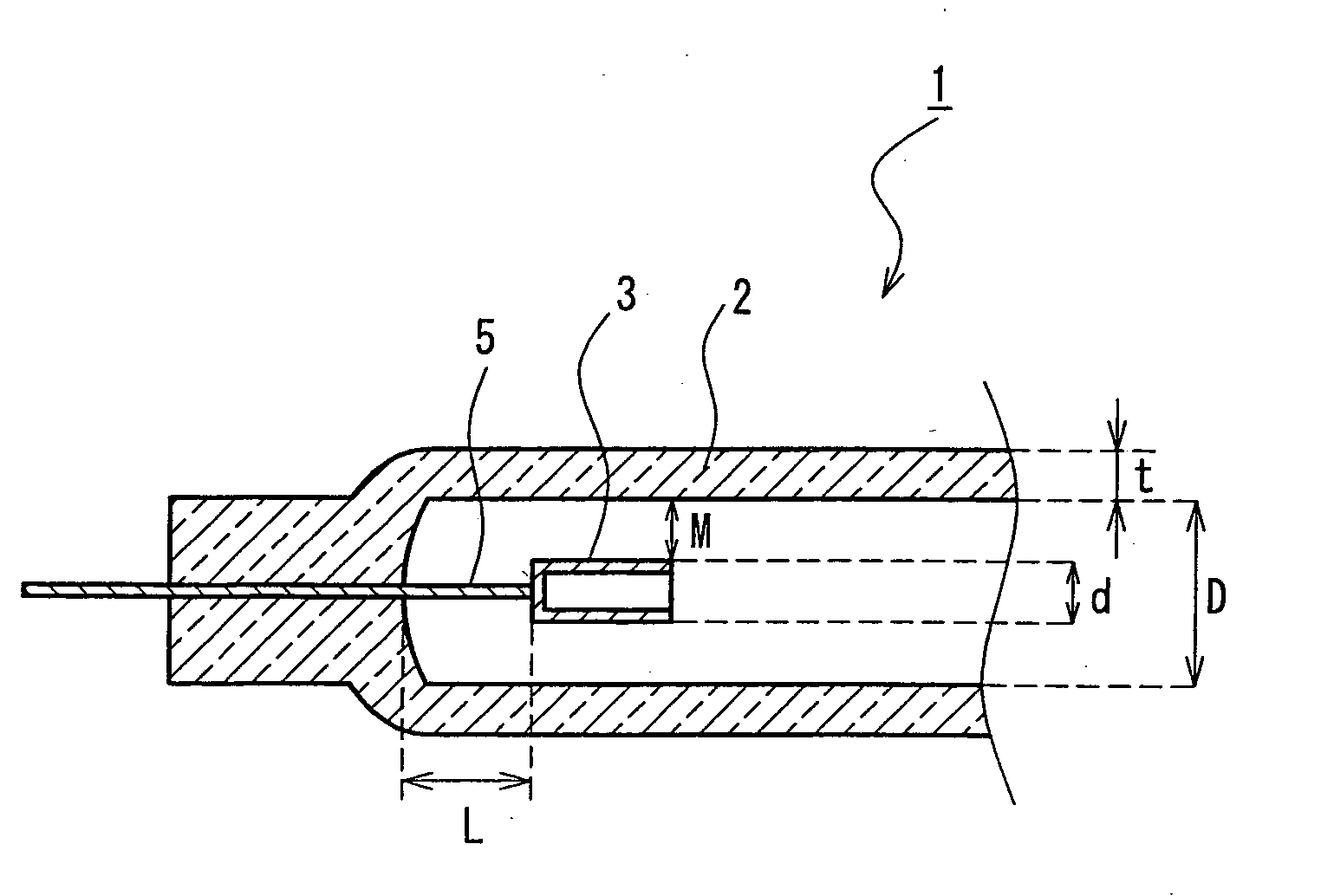Low-pressure dischage lamp and back light device using same
a low-pressure discharge and back light technology, applied in the direction of low-pressure discharge lamps, discharge tubes, luminescent screens, etc., can solve the problems of short lamp life, abnormal glow discharge transition, and decrease of emitted luminous flux
- Summary
- Abstract
- Description
- Claims
- Application Information
AI Technical Summary
Problems solved by technology
Method used
Image
Examples
example 1
First, a low-pressure discharge lamp shown in FIG. 1 was manufactured in the following manner. That is, a three-wavelength-region emitting phosphor having a color temperature of 5,000 K was applied to the inner face of a glass tube in a thickness of about 20 μm. The glass tube was formed from borosilicate glass and had an outer diameter of 1.8 mm, an inner diameter of 1.4 mm, and a length of about 300 mm.
Next, a bottomed cylindrical electrode shown in FIG. 2 was formed. The cylindrical electrode was formed from niobium and had an outer diameter of 1.1 mm, an inner diameter of 0.9 mm, and a length of 1.5 mm. As an interior lead-in wire, a tungsten wire having an outer diameter of 0.6 mm was used. The interior lead-in wire was connected to the cylindrical electrode by resistance welding. In the glass tube, 1,500 μg of mercury and a neon-argon mixed gas of 95 vol % neon and 5 vol % argon were sealed at different sealing pressures, and thus sample lamps that vary in the sealing press...
example 2
Next, with respect only to Sample lamp group (a) described above, the respective composition ratios of argon and neon in the sealed gas were set so as to vary. In this manner, sample lamps that vary in the composition ratios of argon and neon were manufactured and grouped into Sample lamp group (c). With respect to each of the sample lamps, a lighting test was performed so as to determine a cathode glow discharge density (J). The result showed that by satisfying the above-mentioned expression, which is shown below, the following were achieved. That is, rare gas consumption attributable to increased sputtering of an electrode was not caused, normal glow discharge could be maintained, and degradation of a luminous flux hardly occurred. Thus, a long life (50,000 hours) could be secured, and excellent starting characteristics also could be attained up to the end of the life time.
Expression: α≦J=I / (S·P2)≦1.5α
[α=(90.5A+3.4N)×10−3]
In the above-mentioned expression, 1.5α that represents ...
example 3
Next, a cap-like electrode 6 shown in FIG. 7, which had a shape different from that shown in FIG. 2 as the shape used in the case of Sample lamp group (a) described above, was fitted on an electrode bar 7. Using the cap-like electrode 6 and the electrode bar 7, sample lamps for Sample lamp group (d) were manufactured in accordance with various conditions. With respect to each of the sample lamps, a cathode glow discharge density (J) was determined. In this case, Sample lamp group (d) had the same configuration as that of Sample lamp group (c) except for the shape of the electrode. The cap-like electrode 6 had an outer diameter r1 of 0.9 mm and a length l of 2.5 mm. The electrode bar 7 had a diameter r2 of 0.6 mm.
As a result of the above-mentioned determination, with regard to the cathode glow discharge density (J) obtained in the case of Sample lamp group (d), as in the test results obtained in the case of Sample lamp group (c), in each of the sample lamps of a low-pressure disch...
PUM
 Login to View More
Login to View More Abstract
Description
Claims
Application Information
 Login to View More
Login to View More - R&D
- Intellectual Property
- Life Sciences
- Materials
- Tech Scout
- Unparalleled Data Quality
- Higher Quality Content
- 60% Fewer Hallucinations
Browse by: Latest US Patents, China's latest patents, Technical Efficacy Thesaurus, Application Domain, Technology Topic, Popular Technical Reports.
© 2025 PatSnap. All rights reserved.Legal|Privacy policy|Modern Slavery Act Transparency Statement|Sitemap|About US| Contact US: help@patsnap.com



